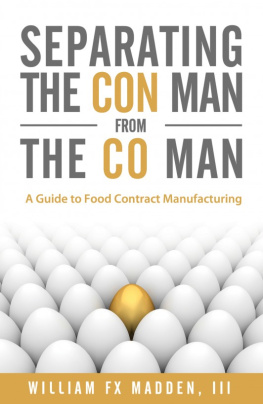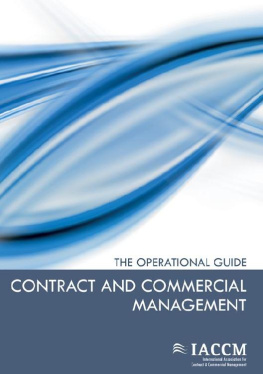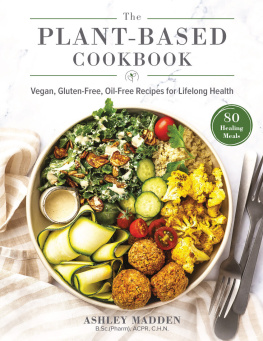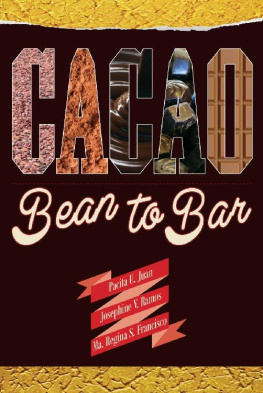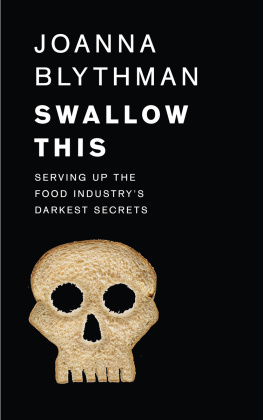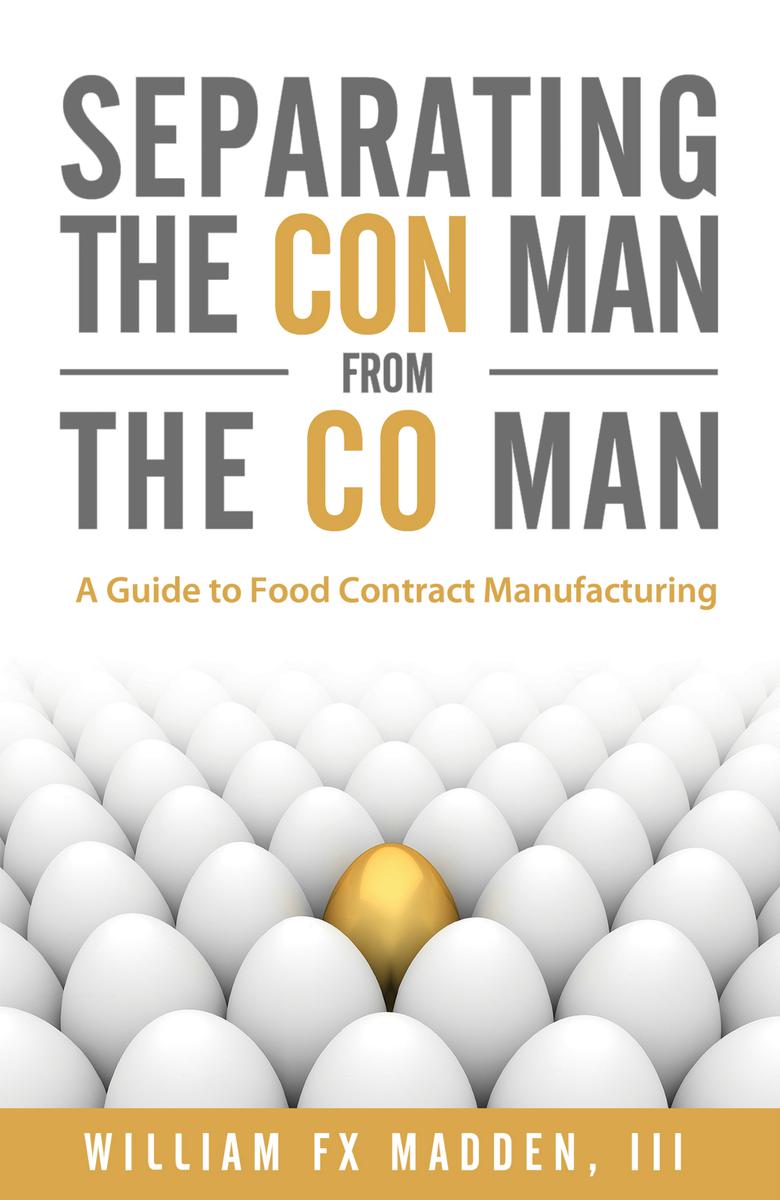
~~~~~
How to Source a Contract Manufacturer
~~~~~
Table of Contents
~~~~~
Introduction
If you are reading this book, you are one ofthree types of people:
1. A person who has always thought that yourproduct X (your grandmothers sauce, your chocolate recipe, etc.)was great, but you dont even know where to start to find acontract manufacturer.
2. A person who has been looking for theneedle in the haystack (contract manufacturer) for the last 6months.
3. A person who has been manufacturing theproduct yourself and realizes that this is a huge distraction andfinancial suck.
This book is for all three types ofpeople.
My name is Will Madden, and Ive worked inthe food industry for the past 18 years. I know the industry insideand out and have seen it all. Ive helped startups andmultimillion-dollar businesses find the perfect contractmanufacturers, setting them up for long-term success.
However, I recognize that not everyone isable to afford my consulting fees. Or perhaps youre a trueDo-It-Yourselfer and figure you will give it a try. Whatever yoursituation, this guide is designed to educate you on the process ofsourcing a contract manufacturer for the food industry.
This book is written in plain,easy-to-understand English. I am not a professional writer, butyoull quickly see that I know my stuff, and I can save you atruckload of trouble if youll listen to what I have to say.
In fact, Id like to start this book outwith a disclaimer. You know, like the disclaimers you see on dietpill labels, saying Not FDA Approved. Here it is:
At times while reading this book, you mayfind yourself thinking something along the lines of, Man... thisWill Madden sure is an arrogant prick.
I want you to be aware that I know this.Some of the things Im going to say in here may rub you the wrongway, and for that, I apologize. My hope is that by the end of thisbook, you will start thinking things like, Man... this Will Maddenis a likable arrogant prick who actually knows this businessinside and out. In fact, I want to buy this guy a couple ofbeers.
The other reason Ive written this book inthis style and tone is because frankly, this subject isnt the mostexciting topic on the planet. At dinner parties, when people ask mewhat I do, their eyes glaze over if I dont spice it up a little.In fact, at times I just say I sell life insurance so I dont haveto go into it. Im warning you in advance: If you get offended by aminor swear word or two, you wont want to read this book. I cursefor emphasis because sometimes there is no better way to saysomethingand it adds entertainment value. Im hoping to get achuckle out of you now and then.
Also, I will be honest, at times brutallyso. I dont sugar coat things; I tell you how it really is. Becausethats what you want to know, isnt it?
There are all kinds of bullshitters outthere who will tell you, You can make your dream come true!without giving you a shred of useful information. Theyll feed youroptimism, but theyll just waste your time, money, and energy. Imall about telling you what the truth is in this industry so you candetermine if you have the drive, resources, and stones to make yourdream business get off the ground.
It is my hope that this book will truly helpyou. I know this industry well because Ive worked on both sides ofthe industry, and Ive negotiated enough contracts to have seen itall. Ill help you identify and avoid the pitfalls of the industryas you pursue your plans to establish or expand your business inthe food industry.
Ready to do this thing?
Then lets get going.
~~~~~
Part I:Understanding the Food Industry Landscape
If youve been thinking about starting yourfood business and are finally ready to take on this challenge, youare in luck. Your timing is impeccable. Want to know why?
Because right now small niche foodbusinesses are the up-and-coming trend. Consequently, there is aton of money going into the industry. Theyre the latest fad, thecoolest thing.
Why?
Because all of the following trends areconverging in your favor:
1. People all over the country areinterested in supporting small businesses.
2. Local, organic, or small-batch productsare considered premium.
3. Healthy alternatives to popular junkfoods are big sellers.
Heres a real life example, something youcan Google and read about right now to see that Im not justblowing smoke up your ass. At this time (Winter 2015), Whole Foodsis sponsoring an effort to support small, local, start-up foodbusinesses. Theyve held workshops along with the city of Chicagowith the Greater Engelwood Community Development Corporationthrough which they inspire small food companies to use commercialkitchens and apply for loans so they can launch their products andsell them in Whole Foods.
This isnt happening just in Chicago.Commercial kitchens and indie food companies are springing up allover the country. Grocery stores like Whole Foods, Earth Fare, andPublix are looking to buy from small niche food companies so theycan cash in on this opportunity. Like any smart business, they aretracking consumer trends and trying to position themselves on thefront end of the movement.
So... youve got three things in your favor:timing, a positive business trend and a move towards health foodsas opposed to junk foods. However, youll need to consider a lotmore than these three factors as you set out to start a business.Read on to learn what you need to know.
~~~~~
Chapter 1: FindingYour Way
As you get started, youll quickly discoverthat you dont know what you dont know. Its my goal to help youfigure out the basic layout of the land so you can navigate thistricky territory. That means you need to learn the terms people inthe industry use and how to talk like someone who has been aroundthe block a time or two. You need to know this information BEFOREyou start approaching co-manufacturers.
Jargon
Before you speak to anyone in this industry,you need to familiarize yourself with the terminology. Thefollowing are terms you will use frequently when discussing yourproduct.
3PL
Third party logistics- Athird-party logistics provider (abbreviated3PL, or sometimes TPL) is a firm that provides service toits customers of outsourced (or "third party")logistics services for part, or all of their supply chainmanagement functions.
Commercialization
The process in which a product is taken fromideation to production.
R&D
Research and development. The process inwhich a concept is developed utilizing consumer insights and thenvetted in the manufacturing process.
Timeline
The amount of time each step in thedevelopment process will take- includes ideation, refinement,sampling, trials and first production.
The Most Important Jargon in ThisIndustry
Its important to understand that in thisindustry, people use the following terms interchangeably:
Contract manufacturer
Co-man
And...
Contract packager
Co-packer
You will want to familiarize yourself with theseterms.
Whats the difference between a co-man and aco-packer?
A co-man, or contract manufacturer, is somebody whoactually manufactures a product for you. For example, Little LadyFoods is a pizza contract manufacturer. They make the dough, bakeit, and put the toppings on. Theyre a manufacturer; they make yourproduct for you.
A co-packer, or contract packager, is somebody whotakes bulk product that has already been produced, and they packageit in a specified way. For example, perhaps you need club packs ofcereal, multi-serves, or displays.
Next page
